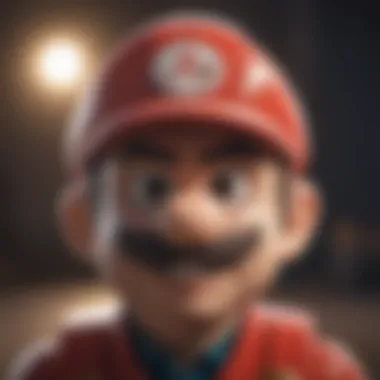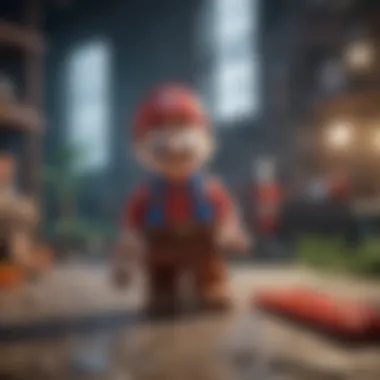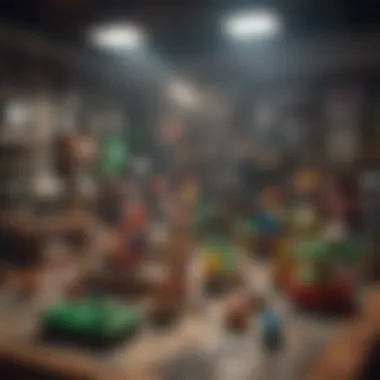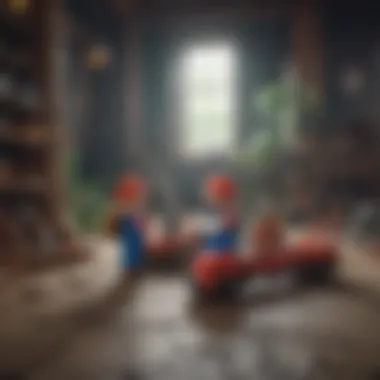Unpacking the LEGO Mario Toy: A Fusion of Play and Nostalgia


Intro
The LEGO Mario toy signifies a unique amalgamation of two prominent franchises – LEGO and Nintendo. This cooperative creation allows fans to engage with the iconic Mario universe in a tangible manner. Through ocean of plastic, they experience not just building, but the thrill of interactive gameplay reminiscent of classic video games.
This article seeks to provide a thorough examination of the LEGO Mario toy. It will assess the design principles, interactive features, and the historical context behind its launch. Readers can expect a dive into the means through which this product engages both casual players and hardcore aficionados, spotlighting how it reshapes the play experience.
Additionally, this exploration recognizes various user interactions with the toy and its educational implications. In summarizing its cultural impact, one grasps how this toy transcends the physical dimension, constructing narratives deeply rooted in both LEGO lore and the gaming cosmos. Particularly for niche communities invested in the legacy of interactive play, this LEGO initiative uniquely blends nostalgia with innovation, marking its significance in the ever-evolving toy industry as well as in the broader cultural landscape.
Intro to LEGO Mario
The LEGO Mario toy holds an esteemed foothold in the realms of both gaming and physical play. The fascination originates aus a unique collaboration that combines the creative building principles of LEGO with the iconic themes and characters of Nintendo’s Mario franchise. This section brings forth an essential understanding of how this product not only serves as a toy but also as a bridge between generations of gamers and enthusiasts, resonating deeply within pop culture.
Overview of the Product
LEGO Mario includes various figures and interactive pieces that invite users to construct their own courses. The initial release featured Mario-themed starter sets, which enabled players to utilize LEGO blocks creatively. Mario himself is no ordinary figure – he is equipped with a tiny screen that displays emotions, coins, and various interactive prompts as he navigates the gummy world you can build with the sets.
Beyond mere visual attributes, the product's functionality plays a significant role in attracting a dedicated fan base. The implementation of sound effects and reactions provides a lively experience that mirrors gameplay found in video games. Moreover, the various expansion sets allow builders to progressively build their unique worlds, merging elements of creation, exploration, and competition, enhancing user satisfaction.
The product’s attention to detail underscores its purpose: to capture the nostalgia surrounding Mario while evolving into a modern and engaging format. With a blend of challenges and playful elements, the LEGO Mario toy skillfully entices both seasoned gamers and new audiences alike.
Collaboration Between LEGO and Nintendo
The partnership between LEGO and Nintendo marks an unprecedented moment in toy history. Emerging from mutual admiration, this collaboration sought to enhance storytelling through the medium of building toys. Nintendo's experience in creating engaging virtual worlds blends seamlessly with LEGO's philosophy of hands-on play.
Collaboration began years prior to the launch, marked by extensive design workshops and focus discussions. This carefully considered approach was vital. Its focus transcended mere gimmicks. Instead, it aimed to encapsulate an experience that harmonizes these two rich universes. Consequently, the fruits of this alliance showcase intricate designs CCould that underpin the commonalities between imaginative play and gaming.
The partnership represents expectations that go beyond toys. It bridges the gap for parents and children, شباب working together to foster an environment full reporters to concentrate upon creativity and cooperative storytelling in unified themes. By uniting two distinctive legacies, LEGO and Nintendo resonate with multiple generations, reinforcing collective admiration through a beloved character like Mario.
In this intersection of play and functionality, we observe not just a toy, but a platform where traditional values of creativity merge with modern interactive storytelling.
Design Features of LEGO Mario
The design features of LEGO Mario are crucial in understanding how this toy operates within the realms of play and nostalgia. This section discusses the physical attributes and technological innovations that make LEGO Mario an engaging experience for users, especially for gamers and fans of the Nintendo brand.
Physical Attributes
LEGO Mario is crafted with precision and attention to detail. Its physical attributes are not just good to look at; they actively enhance user interaction. The figure measures around 3 inches tall and has a distinctive appearance that mimics the beloved video game character. This small stature might be simple, but its design elements are functional.
- The color scheme of LEGO Mario is bright and instantly recognizable, featuring the classic red hat and blue overalls.
- It includes printed features such as eyes and buttons. These additions help in providing a more authentic experience, hitting the chords of nostalgia.
- The size is easy to handle for various age groups, promoting engagement in different levels of play.
Another interesting aspect is the placement of interactive elements on its body. The QR code underneath allows LEGO Mario to interact with other sets and functionalities.
Technological Innovations
The technological innovations in LEGO Mario are at the forefront of its appeal. These features elevate this toy beyond traditional block-building experiences, enabling dynamic interactions.
- Sound Effect Technology: When users perform actions like jumping on enemies or collecting coins, LEGO Mario reacts with various sound effects. This responsiveness creates a more immersive experience that echoes challenges faced in video game gameplay.
- Sensor Mechanisms: Integrated sensors beneath the figure allow it to detect block interactions and environmental setups. This feedback mechanism fosters innovation in creativity and puzzle-solving as users design different levels.
- Companion App Compatibility: LEGO Mario can connect with a smartphone app. Users can track performance, participate in challenges, and customize gameplay. The app also adds an extra layer of learning and fun through animated tutorials and community interactions.
The interplay between these attributes and technologies makes LEGO Mario more than a collection item. It builds a bridge between the digital and physical realms for fans accustomed to game environments.
"LEGO Mario redefines interaction merging playsets with digitals features, setting a new benchmark in kids' toys."


Ultimately, the careful melding of physical attributes and technological innovations creates a foundation for a rich, immersive play experience that holds broad appeal for diverse audiences. As LEGO continues to adapt these features, it remains a powerful paradigm of how toys can evolve with user expectations and cultural shifts.
Interactive Gameplay Mechanics
Interactive gameplay mechanics are a cornerstone of the LEGO Mario experience. They orchestrate the engagement between the user and the toy, enhancing the play experience. Through innovative features, this toy encourages creativity and critical thinking. Knowing how it operates and how it integrates with digital experiences provides invaluable insights.
How the Toy Operates
LEGO Mario operates through a combination of sensors and programmed logic. It is equipped with various electronic components designed to register movements and actions. The color-sensing technology is crucial; it allows Mario to react differently depending on the color blocks he stands on. This simple yet effective mechanism creates a sense of interactivity that keeps players engaged.
Users start by customizing their course using various LEGO blocks. Players can build unique levels before letting Mario traverse through them. As he moves, LED screens display iconic expressions based on the interactions he's experiencing. Factors such as collecting virtual coins or defeating enemies open up more gamified experiences, optimal for enhancing engagement. Furthermore, feedback loops keep users motivated by rewarding their creativity.
Integration with Digital Experiences
Digital integration elevates the LEGO Mario toy in the realm of play. The companion app represents one of many methods used to expand gameplay. With the app, users can access instructions for building courses, track achievements, and even share their unique levels with others online.
This incorporation of technology isn't just for added fun. It fosters connections among users, constructing a community around collaborative play and sharing. Players commend such features, which capture methods for engaging and inspiring those deep-seated feelings of nostalgia while exploring new gameplay gradients. The app serves as a rich platform, further solidifying LEGO Mario's place in the wider spectrum of gaming culture.
Technologies like color sensors and mobile integration redefine gameplay mechanics, creating deeper interactions between players and their creations.
Cultural Impact of LEGO Mario
The cultural impact of LEGO Mario extends beyond mere entertainment. It intertwines with nostalgia, community engagement, and modern play experiences. Recognizing its significance within both the LEGO and Nintendo fandoms allows us to appreciate how this innovative toy serves as a bridge between generations and enhances interactive play.
Community Reception
LEGO Mario received a notably positive response from fans and consumers alike. When launched, the product quickly became a topic of conversation on various platforms, including Reddit and Facebook. Players valued the blend of physical building with digital interactions. Many parents noted that the toy provided a unique bonding opportunity with their children, fostering interaction through shared gameplay.
"LEGO Mario is more than just a toy. It creates moments between generations, turning nostalgia into shared experiences."
Review sites frequently highlighted the multifaceted nature of the toy, focusing on its ability to appeal to both adult fans and younger audiences. Forums discuss fan-made additions and MARIO-centric themed builds, illustrating an engaged community spoiled with countless opportunities for creativity. This interactive experience further strengthens the LEGO brand while serving Nintendo’s essence within contemporary culture. While LEGO develops vast themes, LEGO Mario has cultivated a unique niche that resonates well with consumers.
Nostalgia Factor
The emergence of LEGO Mario taps into a deep well of nostalgia. Both LEGO and Nintendo have established loyal fandoms, with many now adults who grew up enjoying both the brick-based creativity of LEGO and the adventures of Mario. The LEGO Mario sets invoke memories of early gaming experiences, inviting users to recreate iconic levels and characters.
This nostalgic pull is crucial for several reasons:
- Connection to Childhood: Many individuals fondly remember playing Mario games in trivial blocks with early consoles. LEGO Mario evokes those memories vividly.
- Revisiting Design Elements: The attention to detail in recreating classic elements from Mario’s universe attracts longtime fans, reminding them why they loved these games as kids.
- Modern Relevance: While excellent at invoking the past, it's equally effective in combining nuances of 21st-century gaming with traditional playforms.
The melding of the two cultures effectively reminds adult enthusiasts of their past while developing excitement in young generations about iconic gaming histories. This interconnection has established LEGO Mario as not just a currency of nostalgia but also as an entry point to Mario's universe for new audiences.
Educational Benefits
LEGO Mario offers several educational advantages that extend beyond simple playtime. As toys have evolved, the role of educational value in a child’s experience has become a pivotal aspect for both parents and educators. The LEGO Mario franchise encourages children not just to engage but also to learn skills and concepts that are beneficial in real-life contexts. This section will explore how playing with LEGO Mario enriches skills in problem-solving and creativity.
Enhancing Problem-Solving Skills
When children play with LEGO Mario, they encounter various challenges that require critical thinking and problem-solving abilities. Building and customizing levels with these bricks fosters a pragmatic mind that learns to approach issues logically.
“Through building and gameplay, LEGO Mario engages children in a manner that spurs cognitive development.”


This hands-on engagement teaches kids to assess situations, strategize solutions, and think multiple steps ahead. For example, when assembling a course or navigating through levels, children decide the best configurations for obstacles based on how they want Mario to react. It is a tangible way to break down complex tasks into manageable parts, thus honing their analytical skills in the process.
- Key Aspects of Problem-Solving in LEGO Mario:
- Assessing Challenges: Spotting problems and devising strategies to overcome obstacles experience using bricks and characters.
- Trial and Error: Kids learn that failing is part of the process, and this persistence builds resilience, an important life skill.
- Comparison and Analysis: The features of LEGO Mario expose users to comparing different methods through gameplay efficiency.
Encouraging mental agility it turns innocent play into a learning environment that goes unnoticed by many, cementing the idea that LEGO Mario provides more than just playful moments.
Encouraging Creativity
The LEGO Mario encourages kids to immerse themselves in creativity by allowing them to invent their courses, stories, and challenges, thus opening avenues for imaginative thinking. Each start with a base structure of LEGO not only encourages home-building narratives but gives kids agency over their creations.
Through play, children boost their imaginative skills by designing levels that can be replicated or altered, drawing a connection between the virtual world of Mario and the physicality of Lego blocks.
- Creative Expression through LEGO Mario:
- Level Design: Children construct elaborate courses demonstrating problem-solving while customizing the physical space with LEGO bricks.
- Story-Making: Concocting scenarios fosters storytelling skills that are crucial for language development and communication.
- Collaboration: When playing with others, children learn teamwork which involves shared ideas, blending creativity to shape collective experiences.
This kind of engagement with LEGO Mario cultivates a mindset that values creativity over merely designed structures. Instead of just following instructions, the toy's modular nature facilitates innovation and helps children to express their unique ideas in a fun and engaging way.
Comparative Analysis with Other LEGO Toys
Comparative analysis with other LEGO toys is a crucial aspect of understanding the uniqueness of LEGO Mario. It provides insights into the elements that contribute to its distinct approach in the realm of toy performance and engagement. By focusing on this analysis, we can explore specific factors that set LEGO Mario apart while also identifying common themes that resonate throughout the various LEGO product lines. This layer of examination not only enhances comprehension of LEGO Mario's appeal to consumers, especially gamers and Nintendo fans, but allows for an appreciation of its innovative aspects compared to traditional offerings.
Similarities with Other Themes
Several features unify LEGO Mario with other LEGO themes, making it recognizable to fans.
- Both celebrate creativity: Like LEGO Star Wars and LEGO Harry Potter, the LEGO Mario series engages users through imaginative construction.
- Adaptability and playability: Many LEGO lines exhibit interchangeable parts and constructions; for example, the modular approach seen in LEGO Ninjago encourages thematic storytelling dynamics.
- Printable accessories: Just as LEGO Friends offers lifestyle narratives that children can relate to, LEGO Mario supports personalization through stickers and avatars. This variabilty can make portraits of game characters and experiences quite immersive.
These parallels reveal that while LEGO Mario is distinct in its relationship to the Nintendo franchise, it functions within a broader, proven LEGO framework that emphasizes exploration and creation.
Differences in User Engagement
The engagement process for LEGO Mario differs notably compared to other LEGO themes, shaping user interaction.
- Digital integration: Many traditional LEGO sets rely on static designs, whereas LEGO Mario embodies a hybrid model, combining physical sets with digital interactions. Gamers can manipulate an interface that constantly shifts as they navigate the Lego Land, tapping into the nostalgia of video games in real-time play.
- Game mechanics: The aspect of scoring and gameplay inserts a competitive edge uncommon among most LEGO selections like LEGO City or LEGO Creator sets. Through achievements and digital innovation, it aligns more with gaming experiences than mere construction.
- Age appeal: While other lines often cater to various age ranges, LEGO Mario particularly leverages the nostalgia factor for adult fans rebounding their childhoods. Besides children, a significant percentage of buyers grows from adults seeking to capture cherished memories, drawn into a participatory environment reflective of gaming journeys.
The analysis shows fundamental differences between how LEGO Mario engages its audience and the methods presented by other LEGO toys. Willingly interactive, this design propels it into hybrids of diverse play styles, demonstrating how modern toys evolve in current entertainment landscapes.
Understanding how LEGO Mario is both similar to and different from traditional LEGO toys informs its status as a youthful innovation while enhancing engagement for diverse users.
An exploration into the comparative traits delineates the juxtaposition captured through LEGO Mario, shedding light on substantial themes in user connection, innovation development, and interpretative nostalgia that transcends ages in meaningful play.
Development Process of LEGO Mario
The development process of LEGO Mario is a crucial aspect of understanding its architecture, dynamics, and appeal. It encapsulates the journey from an idea to a tangible product that many cherish today. The evolution process gives insights into the collaborative efforts of talented teams, where various considerations shape a single toy. The depth of this journey underscores not just craftsmanship but also intricate planning that resonates with both gamers and LEGO enthusiasts.
From Concept to Production
The phases that lead from concept to production are inherently multi-layered for LEGO Mario. It often begins with brainstorming sessions involving designers, engineers, and marketing experts who collaborate to harness both LEGO's creative freedom and Nintendo's rich gaming tradition. This leads to sketching initial designs that capture Mario's essence while ensuring matchless compatibility within the LEGO ecosystem.


Following the ideation, rigorous playtesting ensues. This initial iteration is crucial since feedback is essential to refine mechanics suited to both young and older users. During this time, concepts like interactivity and accessibility are analyzed to strike a necessary balance between charm and functionality.
The primary goal for the team is to ensure that the iconic nature of Mario shines through while making an innovative turn in how play is experienced. For example, integrating varied sound effects is meant to replicate moments from the video game series, creating a seamless transition between interactive physical play and digital gaming environments.
Material selection plays an important role next. The end-game is to create a product that withstands rigorous play while remaining visually appealing. Consequently, various prototypes are tested for durability and enjoyment. Considerations may include color schemes and tactile experiences to enhance player engagement.
Once finely tuned, LEGO Mario enters mass production. At this stage, production lines are carefully aligned, ensuring that the charm and integrity are carried through every unit produced.
Collaboration Dynamics
The collaboration between the teams at LEGO and Nintendo is fundamental to the entire process. Each company’s expertise plays a vital role, where technical skills around mechanics meet a legacy of beloved characters. This synergy fosters an environment where innovation arises organically. Regular communications and brainstorming sessions help cement modifications during development, as both parties actively contribute ideas steeped in their brand identities.
Diverse perspectives are encouraged, allowing diverse insights into what may work or resonate with audiences.
In many case studies, instances where challenges arise are tackled together. For the LEGO Mario toy, considerations revolve around gaming culture's shifting landscapes and how that influences modern toy experiences. In understanding this dynamic over how fans interact, avenues for meaningful engagement on both physical and digital fronts continue to expand.
Overall, LED Mario symbolizes how productive collaboration can yield rewarding results for fans and participants alike. Collectively, both LEGO and Nintendo cover a spectrum where novelty meets nostalgia, promising unique experiences that enrich the toy's journey. The fusion of advanced toy technology and gaming continues to define this boundary, leading to delightful innovations ensured by well-coordinated efforts.
The collaboration dynamics behind products like LEGO Mario emphasize the growing need for unity between traditional play and digital gaming worlds, paving the way for progressively intricate player interactions.
Future of LEGO Mario and Brand Collaborations
The LEGO Mario toy represents a notable merging of physical play with digital interaction. Understanding its future is crucial for fans and marketers alike, hinting at potential directions for product development and brand endorsements. This section investigates two primary facets: potential expansions in current product lines, and future collaborations across the toy industry. Both elements play a vital role in shaping user experience and sustaining interest within the evolving markets of toys and gaming.
Potential Expansions
The potential for expanding the LEGO Mario product line is substantial. Based on the toy's initial success, it is plausible to anticipate new sets that introduce.*?) items, levels, and characters. Each addition can invigorate playtime, enhancing both engagement and enjoyment. Here are some likely expansion ideas:
- New Characters: Introducing more characters from the Mario universe. Include villains like Bowser or supporting characters like Toad.
- Themed Sets: More varied landscapes inspired by other Mario games such as Super Mario Galaxy or Mario Kart.
- Accessory Packs: Items like power-ups and additional LEGO pieces to customize user interactions.
- Collectible Items: Small, limited-edition items that cater to dedicated collectors, balancing quality and value.
These expansions can create renewed interest, encouraging both fans of LEGO and Nintendo to revisit the product line. As players incorporate new features and products, the overall experience will likely be enhanced, paving the way for more complex interactions and installations that bridge creativity and nostalgia.
Future Collaborations in the Toy Industry
Brand collaboration has become essential in the toy industry, fostering innovation and cross-pollination among various franchises. The success of LEGO Mario enhances opportunities for future partnerships with other icons in gaming and pop culture. Possible collaboration trajectories include:
- Interactive Technology: Tying up with tech companies to enhance gameplay.
- Movie Tie-ins: Similar to LEGO's tie-in with the recent Mario movie, expanding themes into cinematic releases.
- Games Integration: Integrating new playsets with systems like Nintendo Switch.
Such collaborations are not mere marketing stunts. They revitalize the products in the marketplace by offering fresh interactions. Cross-brand opportunities are beneficial as they secure the allegiance of die-hard fans from both franchises.
The merging of iconic communities through collaboration is rich with potential, often enhancing the overall experience for a wide array of consumers.
In summary, both potential expansions and future collaborations promise dynamic growth for LEGO Mario's brand. Keeping in mind the evolving landscape of the toy industry, it is reasonable to anticipate exciting products and partnerships ahead. As technological advancements continue shaping play, the universe of LEGO Mario has more opportunities for creativity and exploration.
End
The conclusion serves as a critical component in understanding the LEGO Mario toy and its multifaceted role within the larger context of both LEGO and Nintendo. This section draws together the key points discussed throughout the article, ensuring that readers grasp the broader implications of this innovative product.
Summary of Key Insights
In summary, the LEGO Mario toy is more than a simple plaything; it represents the fascinating intersection between the physical and digital gaming worlds. Major points include:
- Design Innovations: Its unique physical features and interactive elements distinguish it from traditional LEGO sets, making it a highly engaging toy.
- Cultural Significance: The collaboration between LEGO and Nintendo taps into a rich legacy, appealing to both gamers and builders.
- Educational Value: The gameplay mechanics encourage problem-solving skills and foster creativity among users.
These points show how LEGO Mario effectively bridges the gap between nostalgic connections to classic gaming while providing enriching play experiences.
Final Reflections on LEGO Mario's Legacy
As we consider LEGO Mario's ongoing legacy, it is essential to reflect on its impact in both toy and gaming communities. Users around the globe enjoy a lively new range of interactive and immersive play scenarios. The ability to combine building with virtual gameplay reinforces LEGO's position as a multi-generational brand that values creativity and technological advancement. Furthermore, the LEGO Mario toy will likely inspire future collaborations within the toy industry, enhancing how toys engage with digital landscapes. Such engagement ticks the critical box for relevance in today's fast-paced entertainment environment. Ultimately, LEGO Mario represents a lasting legacy that combines gameplay, education, and community in a uniquely engaging focal point. The merger of LEGO creativity and Nintendo gaming culture will likely influence new product developments and captivate fans for years to come.



